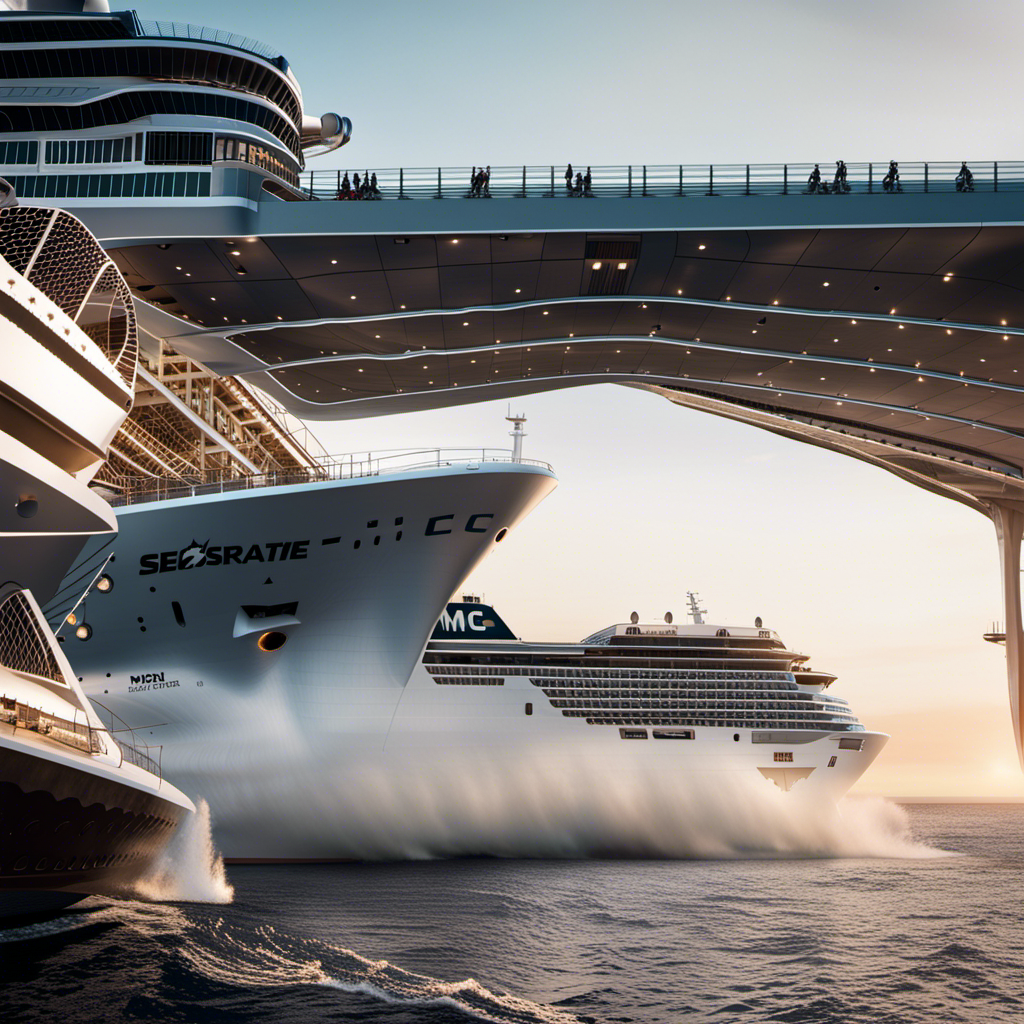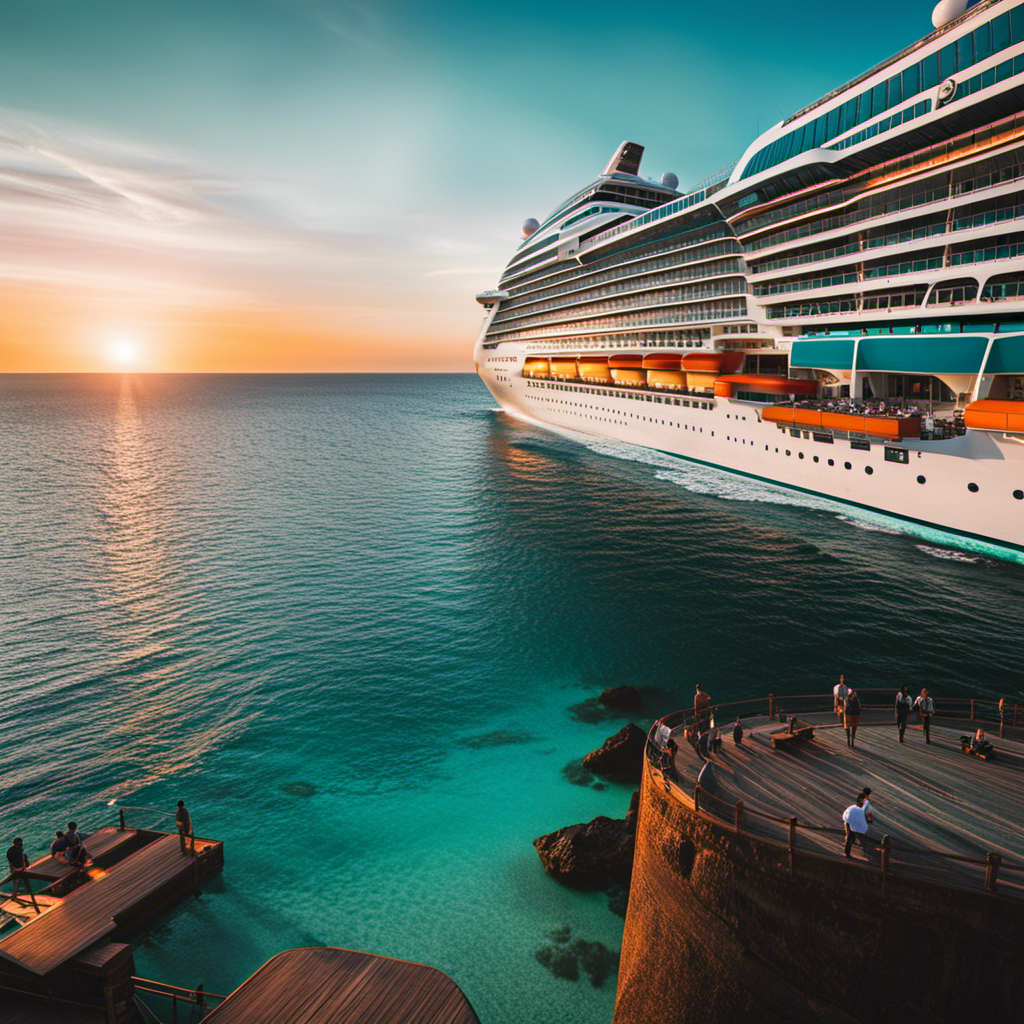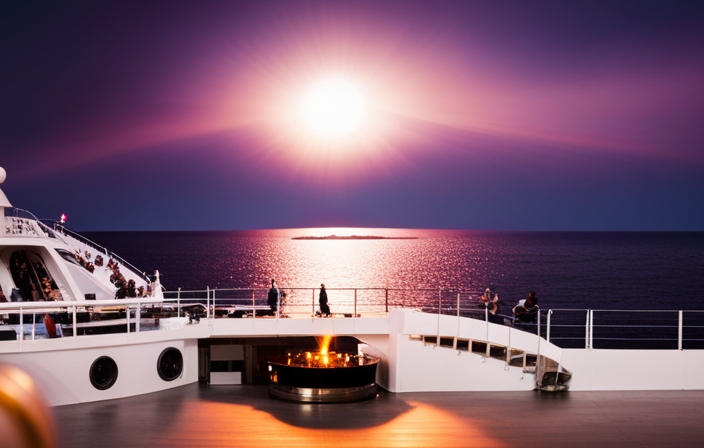Hi there! I’m excited to present to you the exceptional MSC Seashore, a leading example of sustainable cruise travel. This contemporary ship is equipped with cutting-edge environmental and nautical advancements, establishing a fresh benchmark in the industry. It features advanced waste management and recycling systems, water treatment solutions, and methods for recovering energy and heat, marking it as a remarkable accomplishment. Additionally, its water-lubricated propeller shafts improve its environmental friendliness. Join us on a journey to discover the MSC Seashore and see how it’s revolutionizing the cruising experience in a positive way.
Key Takeaways
- MSC Seashore sets a new standard for sustainability in the cruise industry.
- The ship employs advanced technology for waste management and recycling.
- Advanced water treatment systems prioritize water conservation.
- The energy and heat recovery system maximizes power generation and reduces emissions.
Equipped With Advanced Environmental and Maritime Technology
I’m impressed with how the MSC Seashore is equipped with advanced environmental and maritime technology. This cruise ship has truly set a new standard for sustainability in the industry. The benefits of such advanced environmental technology on cruise ships are tremendous. The state-of-the-art waste management and recycling systems ensure that waste is properly managed and disposed of, minimizing the impact on the environment. The advanced water treatment systems ensure that water is treated and reused efficiently, reducing water consumption. Additionally, the advanced energy and heat recovery system helps to reduce energy consumption and greenhouse gas emissions. The impact of advanced maritime technology on sustainability efforts is significant. The water-lubricated propeller shafts, for example, promote environmental viability by reducing the risk of oil spills and minimizing underwater noise pollution. Overall, the MSC Seashore’s advanced environmental and maritime technology plays a crucial role in creating a more sustainable cruising experience.
State-of-the-Art Waste Management and Recycling Systems
Equipped with state-of-the-art waste management and recycling systems, the ship ensures efficient and sustainable handling of waste materials. The importance of proper waste management and recycling cannot be overstated. MSC Seashore’s advanced technology allows for the proper disposal and recycling of waste, minimizing its impact on the environment. The ship employs a waste to energy conversion system, which converts waste into usable energy, providing multiple benefits. Not only does this system reduce the volume of waste that needs to be disposed of, but it also generates energy that can be used onboard. This reduces the ship’s reliance on external energy sources and contributes to a more sustainable cruising experience. Proper waste management and recycling play a crucial role in minimizing pollution and preserving our environment for future generations. MSC Seashore sets a new standard in sustainable waste management practices within the cruising industry.
Advanced Water Treatment Systems
The advanced water treatment systems on board ensure the efficient and responsible management of water resources. MSC Seashore is equipped with innovative filtration systems that prioritize water conservation practices. These cutting-edge technologies play a crucial role in maintaining the ship’s sustainability and minimizing its environmental impact.
One of the key features of the advanced water treatment systems is the utilization of innovative filtration systems. These systems employ state-of-the-art techniques to remove impurities and contaminants from the water, ensuring its cleanliness and safety. The ship’s filtration systems are designed to be highly efficient, effectively removing pollutants and minimizing water wastage.
To provide a better understanding of the advanced water treatment systems on MSC Seashore, the following table highlights some of the key features and benefits:
| Features | Benefits |
|---|---|
| Innovative filtration | Ensures clean and safe water |
| Efficient water treatment | Minimizes water wastage |
| Advanced purification | Removes impurities and contaminants |
| Responsibly manages water resources | Contributes to sustainable cruising |
| Supports water conservation practices | Reduces environmental impact |
These advanced water treatment systems demonstrate MSC Cruises’ commitment to sustainability by implementing responsible practices and utilizing innovative technologies to conserve water resources. By prioritizing water conservation and employing innovative filtration systems, MSC Seashore sets a new standard for sustainable cruising.
Advanced Energy and Heat Recovery System
With its state-of-the-art energy and heat recovery system, MSC Seashore maximizes power generation while minimizing waste. This advanced technological innovation brings numerous benefits to the ship’s efficiency and sustainability. The energy and heat recovery system allows for the efficient utilization of waste heat generated during the ship’s operations, reducing energy consumption and greenhouse gas emissions. By capturing and repurposing waste heat, the system significantly improves the overall energy efficiency of the ship. This not only reduces the environmental impact but also enhances the ship’s operational reliability and cost-effectiveness. The advanced technology employed on MSC Seashore showcases the cruise industry’s commitment to sustainable practices and responsible travel. It demonstrates how technological advancements can revolutionize the industry by combining luxury and relaxation with environmentally friendly solutions.
Water-lubricated Propeller Shafts for Environmental Viability
I really appreciate how the water-lubricated propeller shafts contribute to the environmental viability of the ship. These innovative shafts offer numerous benefits for the marine environment, surpassing traditional systems in terms of efficiency and performance. Here are three key advantages of water lubricated propeller shafts:
-
Reduced pollution: Water lubricated propeller shafts eliminate the need for oil lubrication, reducing the risk of oil leakage and minimizing the pollution of marine ecosystems. This is particularly important in sensitive areas such as coral reefs and marine reserves.
-
Enhanced energy efficiency: Water lubricated propeller shafts greatly reduce friction and drag, resulting in improved fuel efficiency and reduced greenhouse gas emissions. By optimizing propulsion systems, these shafts contribute to the ship’s overall energy-saving capabilities.
-
Lower maintenance costs: Compared to traditional oil-lubricated systems, water-lubricated propeller shafts require less maintenance and have a longer lifespan. This reduces the need for costly repairs and replacements, contributing to the ship’s economic sustainability.
Overall, the implementation of water-lubricated propeller shafts on the MSC Seashore demonstrates MSC Cruises’ commitment to sustainable practices and the preservation of the marine environment.
Largest Cruise Ship Ever Built in Italy
Supported by General Electric (GE) Marine Solutions, the largest cruise ship ever built in Italy requires substantial power, generated by its electric propulsion system. This ship is the result of the largest shipbuilding project in Italy and showcases innovative features for passenger comfort and enjoyment. With its larger dimensions, the ship offers more generous public spaces and an increased number of staterooms. Passengers can indulge in luxury and relaxation without compromising responsible travel. One of the standout features of this ship is the wrap-around promenade, providing opportunities for outside dining and relaxing. MSC Seashore is a testament to MSC Cruises’ commitment to sustainability, as it is equipped with advanced environmental technology, such as state-of-the-art waste management and recycling systems, advanced water treatment systems, and an advanced energy and heat recovery system. This ship is not only a marvel of engineering but also a testament to the cruise industry’s efforts to provide environmentally-friendly and enjoyable experiences for passengers.
Substantial Power Requirements
The substantial power requirements of the largest cruise ship ever built in Italy are met by its electric propulsion system, which generates more power than previous ships. This power generation capacity is crucial for the ship to operate efficiently and provide all necessary amenities to its passengers. To ensure energy efficiency, the ship incorporates various measures such as advanced environmental and maritime technology, state-of-the-art waste management and recycling systems, advanced water treatment systems, and advanced energy and heat recovery systems. Additionally, the ship is equipped with water-lubricated propeller shafts, which not only support the mechanization provided by General Electric (GE) Marine Solutions but also contribute to the ship’s environmental viability. With these energy efficiency measures in place, the ship can navigate the seas while minimizing its impact on the environment.
Electric Propulsion System for Increased Power Generation
In my research on the MSC Seashore, I have discovered that it is equipped with an electric propulsion system, which generates more power than previous ships. This advanced technology is supported by General Electric (GE) Marine Solutions and is a major step towards the future of electric propulsion in the maritime industry.
Electric propulsion systems offer numerous benefits, including increased power generation, improved fuel efficiency, and reduced emissions. By utilizing electricity as the main source of power, these systems reduce the reliance on traditional fossil fuels, resulting in a more sustainable and environmentally-friendly solution for the cruise industry.
The future of electric propulsion looks promising, as more and more companies are recognizing the benefits and investing in this technology. As we strive towards a greener and more sustainable future, electric propulsion systems will play a crucial role in reducing the environmental impact of the maritime industry.
Supported by General Electric (GE) Marine Solutions
I am fascinated by the involvement of General Electric (GE) Marine Solutions in the development of the electric propulsion system on the MSC Seashore. GE Marine Solutions has played a crucial role in supporting the power generation capabilities of this magnificent cruise ship. The electric propulsion system on the MSC Seashore generates more power than previous ships, making it the largest cruise ship ever built in Italy. GE Marine Solutions has contributed to this achievement by providing advanced technologies and expertise.
One notable aspect of GE Marine Solutions’ involvement is the use of water-lubricated propeller shafts. These propeller shafts offer significant environmental benefits. Unlike oil-lubricated shafts, water-lubricated shafts eliminate the risk of oil leakage, reducing the potential for marine pollution. Furthermore, water-lubricated shafts require less maintenance and have a longer lifespan, resulting in reduced operational costs and environmental impact.
Overall, General Electric’s role in developing the electric propulsion system and incorporating water-lubricated propeller shafts on the MSC Seashore demonstrates their commitment to environmental sustainability in the maritime industry. Their innovative solutions contribute to a greener and more efficient cruising experience.
MSC Cruises’ Commitment to Sustainability and Recognition in the Industry
Since 2003, MSC Cruises has built 19 ships and appointed an environmental officer to address environmental issues and ensure sustainable practices. MSC Cruises’ commitment to sustainability and industry recognition is evident through their green initiatives in the cruise industry. They have implemented sustainable practices in the maritime sector, demonstrating their environmental stewardship in the cruise industry. MSC Cruises is dedicated to eco-friendly initiatives in the cruise sector and has been recognized for their sustainable initiatives and achievements. They take their environmental responsibility in the cruise industry seriously and are actively promoting sustainability. Recognizing MSC Cruises’ sustainability efforts is crucial in promoting sustainable practices in the cruise industry. MSC Cruises has set environmental achievements and goals to further contribute to a greener future. Their commitment to sustainability is commendable and serves as a model for the entire industry.
Frequently Asked Questions
How Does the Advanced Environmental Technology on MSC Seashore Contribute to Sustainable Cruising?
The advanced environmental technology on MSC Seashore greatly impacts the cruise ship industry. Sustainable practices enhance the cruise experience by ensuring responsible travel, promoting eco-friendliness, and prioritizing luxury and relaxation without compromising the environment.
What Specific Features Make the Waste Management and Recycling Systems on MSC Seashore State-Of-The-Art?
The waste management and recycling systems on MSC Seashore are state-of-the-art, featuring cutting-edge technology and processes. They ensure efficient waste disposal and maximum recycling, reducing the ship’s environmental impact and promoting sustainable cruising.
How Do the Advanced Water Treatment Systems on MSC Seashore Ensure the Preservation of Marine Ecosystems?
Advanced water treatment systems on MSC Seashore ensure marine ecosystem preservation. These systems employ cutting-edge technologies to treat and purify wastewater before it is safely discharged, minimizing the impact on marine life and maintaining the health of the ecosystem.
Can You Explain the Working Principle of the Advanced Energy and Heat Recovery System on MSC Seashore?
The working principle of the advanced energy and heat recovery system involves capturing waste heat from various sources and converting it into usable energy. This system helps maximize energy efficiency and reduces the environmental impact of the cruise ship.
What Are the Benefits of Using Water-Lubricated Propeller Shafts for Environmental Viability on MSC Seashore?
Using water-lubricated propeller shafts on the MSC Seashore enhances environmental viability. How? By reducing friction, decreasing emissions, and minimizing the impact on marine life. It’s a sustainable solution for a greener cruising experience.
Conclusion
In conclusion, the MSC Seashore showcases cutting-edge environmental technology, making it a sustainable cruising option. With advanced waste management and recycling systems, water treatment systems, and energy and heat recovery systems, the ship prioritizes eco-friendliness. Water-lubricated propeller shafts further enhance its environmental viability. Supported by General Electric (GE) Marine Solutions, the ship’s electric propulsion system ensures increased power generation. MSC Cruises’ commitment to sustainability has been recognized in the industry, solidifying their position as the most eco-friendly cruise line. The Seashore sets a new standard for environmentally conscious cruising.










